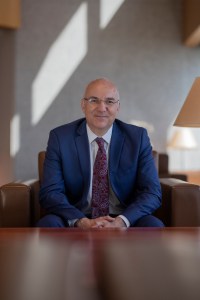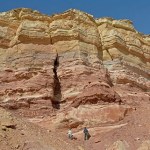Has your story encountered the energy transition yet? Or are you wondering how to future-proof your career in geosciences? If so, the EAGE Decarbonization & Energy Transition community has something special for you with our Energy Transition Stories, a series of live interviews with experts sharing their path and advice.
The first episode took place on 25 June with Philippe Montagnier, Vice President Geoscience Discipline at TotalEnergies. Montagnier is on the exploration leadership team and is also responsible to lead the mid-to-long-term studies and projections of the discipline in terms of activities, technologies and skills.
During the interview Montagnier talked about future opportunities for geoscientists interested in developing their career towards the energy transition, how to build a smart multi-career track and the skills set needed to navigate this rapidly evolving domain. The interview was moderated by Philip Ringrose (Equinor and NTNU), followed by a Q&A with the audience.
Below is a transcript of the interview for everyone who missed and those who wish to go back to the key messages shared by Montagnier.
Hello everyone and welcome to this “Energy Transition Stories” Interview. Today we have the chance to interview Philippe Montagnier on the topic of geoscience careers. Hello Philippe, first please can you introduce yourself?
 I am the VP of the Geoscience Discipline at TotalEnergies. My role is to recruit, train and develop the technical skills of the 1,300 geoscientists in our company – whatever they do (exploration, development/production or R&D), and wherever they work, (at HQ in France or in affiliates). I am also part of the Exploration Leadership Team and participate in decisions and investments that we make in Exploration.
I am the VP of the Geoscience Discipline at TotalEnergies. My role is to recruit, train and develop the technical skills of the 1,300 geoscientists in our company – whatever they do (exploration, development/production or R&D), and wherever they work, (at HQ in France or in affiliates). I am also part of the Exploration Leadership Team and participate in decisions and investments that we make in Exploration.
On the Discipline side, my role is to lead the mid-to-long-term studies and projections of the discipline in terms of our activities, technologies and skills, thereby managing the talent pools and influencing R&D programs.
Thanks Philippe. Maybe a first question before we talk about geoscience and the energy transition is “What is in your view the ideal profile of a geoscientist?”
Through their education, training and experience, a geoscientist’s profile is a combination of engineering, descriptive science, modelling and data science (i.e., data analysis, numerical methods, programming, data management). A geoscientist is comfortable with poorly posed questions or ill-constrained problems. They know how to handle uncertainties and assess risks.
![]() These attributes allow geoscientists to be
These attributes allow geoscientists to be
easily distinguished from engineers within an energy company.
By working in exploration or development/production, geoscientists develop experience in managing seismic or well operations and quickly establish a strong consideration for HSE. They can adapt to scale (from basin to prospect or field, to well logs, to rock samples, to thin sections and microscopic, to even molecular analysis) and to develop reasoning by drawing comparisons and analogies between different concepts and experiences.
![]() Geoscientists are creative and courageous,
Geoscientists are creative and courageous,
on both the technical and business side.
On the technical side, they embark on the ‘treasure hunt’ of exploration and are able to run models to accurately represent the reservoir after its discovery. On the business side, they can manage new ventures, or maximise opportunities that have been discovered by others. They quickly develop business acumen and a sense of conviction to gain support from management and partners to spend tens of millions of dollars on a risky idea or an ambitious development. They have the ability to work in multi-skilled teams, to manage projects, portfolios of mining licenses, budgets. They can react quickly to surprises. They show resilience in difficult situations, for example a dry well, a lost bid or unexpected results during field appraisal.
OK. But then what is your advice for new geoscientists wanting to develop their career in a smart way for the energy transition?
The energy transition will take time and so there will be a need for subsurface oil and gas geoscientists for many years to come. We cannot change a 5,000 billion dollar-a-year business overnight.
There is no human life or progress without affordable and reliable energy, and we must make this energy as clean as possible, as quickly as possible.
Seasoned geoscientists have the option to continue exploring or producing ‘advantaged’ hydrocarbons, i.e., low cost, lower emission oil to replace favorably existing production, or gas that will replace coal power-fired plants to generate cleaner electricity. So, working as a classical O&G geoscientist is also making a concrete and responsible contribution to the net zero ambition of humankind.
Carbon Capture and Storage is an activity that is likely to develop in the future to help achieve net zero. This will require geoscientists to select and monitor the best end-of life fields or large saline aquifers to store geologically CO2.
Based on their versatile profiles, seasoned geoscientists could also develop a career beyond the subsurface, such as business or data analysis, modeling, strategy, business development, Joint Venture or project management for renewables.
Often geoscientists, whether that is fresh graduates or experienced geoscientists, have had basic training in biology/agronomy and geotechnics – two domains that are expected to be in demand in the future, either for nature-based solutions (typically reforestation) for CO2 emission compensation, or developing new biofuels of second to third generation for the former, or wind farms or new hydraulic power plants for the latter.
But what about renewable energy, maybe it does not need any geoscientists?
![]() The transition to renewable energy will require a lot of innovation, engineering, time and money. The need for geoscientists, or natural scientists will remain.
The transition to renewable energy will require a lot of innovation, engineering, time and money. The need for geoscientists, or natural scientists will remain.
We have already discussed how O&G exploration and production will continue, albeit with an energy mix evolving more towards gas to displace coal for electricity generation. We have also talked about the critical role of CCS in achieving net zero, which would require developing skills among staff in hydrogeology, mineral geochemistry, geomechanics and low-cost geophysics to monitor the integrity of the geological storage and the displacement of the CO2 front in the aquifer. We have also mentioned the use of geotechnics for wind farms and hydropower, but we could also add hydrology.
Remote sensing will become increasingly important in order to model the direction and strength of offshore wind to better locate wind turbines. It will also be key to monitor forest preservation and regeneration. Geophysics with ground or airborne sensors could also help operational efficiency and the maintenance of wind or solar farms.
The need for more data science and modelling is also required. This is an area in which geologists and geophysicists are particularly strong, with many applications in solar, wind, power grid modelling, energy efficiency, etc.
Geothermal energy is likely to develop in the future, which is a natural activity for O&G geoscientists.
The energy transition will require the mining and fabrication of many materials like concrete/cement, steel (i.e. iron), aluminium, copper, nickel, cobalt, lithium and rare earth that will be used for photovoltaic cells, wind turbines (structure, magnets), batteries and powerlines. Geoscientists will be required for exploring, producing and recycling these metals to sustain the renewable energy and transportation industries. We could also add the mining and recycling of uranium, as nuclear energy, will be also part of the low carbon mix.
Thanks Philippe, it was really good to get your perspectives on these questions. As a final word, I wonder if you have a good story to tell us to illustrate the diversity of career in geoscience?
Certainly. Careers in a large Energy Company can be quite unusual and highlight the qualities of a geoscientist in their forward-looking spirit, agility and resilience. This will be reinforced in the context of the energy transition with many more multi-energy career path opportunities – from the traditional O&G, to carbon storage, to the use of geothermal to heat our facilities and reduce our emissions, through to surface activities in offshore wind, solar plants, biogas facilities, forest restauration, etc.
Let me share two career path examples to illustrate the diverse career opportunities available.
The first story is Chris’, who started as research geophysicist. He then resigned to complete an MBA and was hired again later, first on an asset management role in Abu Dhabi, then to market gas in Argentina, as economist at HQ, then in Qatar as business developer, as managing director in Montevideo to manage an exploration project in Uruguay. He then took the head of group procurement at HQ before he returned to Abu Dhabi as managing director.
The second interesting career path is Christine’s story. After a long career in geoscience in exploration and development/production, she moved to TotalEnergies Carbon Neutrality Ventures in San Francisco, the group’s capital risk fund that seeks promising start-ups in the low-carbon and carbon neutrality fields.
Both agree that thanks to geoscience they have developed mental plasticity: what you believe to be true one second, is no longer true the next! Studying geoscience is a lesson in the art of humility and perseverance because the subsurface model is, by definition, false. Even so, you must keep the model updated and to do that you need unfailing curiosity, an ability to always listen to different ideas and constant energy. In business, all these qualities are exactly the same. You can propose dozens of different contracts to the same client, thinking you know what your client wants, only to have to completely reshuffle your offer.
![]() Active listening, mental flexibility, curiosity, resilience, and passion are essential in the management of a project and a team, especially in times when we need to transform ourselves in a broad energy company.
Active listening, mental flexibility, curiosity, resilience, and passion are essential in the management of a project and a team, especially in times when we need to transform ourselves in a broad energy company.






